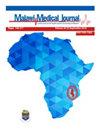圣弗朗西斯医院凯特区放射申请表的充分填写:赞比亚的临床审计
IF 0.8
4区 医学
Q4 PUBLIC, ENVIRONMENTAL & OCCUPATIONAL HEALTH
引用次数: 0
摘要
背景:大多数成像检查使用电离辐射,这会对人体产生生物效应。出于这个原因,只有合理的检查应要求充分填写放射科申请表(RRF)由临床医生。RRF允许放射技师和放射科医生评估与医疗辐射照射相关的益处是否超过风险。不充分或不正确填充的rrf会导致不必要的辐射暴露、成像错误和检查延迟。因此,本研究的目的是审计赞比亚凯特区圣弗朗西斯医院完成一般rrf的情况是否充分。方法本研究是一项定量研究,对2020年1月至12月普通x线摄影的rrf进行审计。使用清单从974个RRFs中回顾性收集数据。对填写的表格进行评估,以确定与患者、检查和转诊临床医生相关的信息是否完整。数据分析采用描述性统计。完整性的标准是基于皇家放射学院(RCR)的指导方针,要求在RRF上完成所有指定的变量。结果N=881例(90.5%)患者RRFs填写不全。在患者识别方面,分别有N=4(0.5%)、N=597(61.3%)、N=3(0.4%)和N=2(0.3%)的RRFs没有患者姓名、医院编号、年龄和性别。关于检查结果,分别有N=3(0.4%)、N=68(7%)、N=449(46.2%)和N=336(37%)例RRFs没有要求的检查、适应证、临床病史和紧急程度。关于转诊者,结果显示N=135(13.9%)、N=173(17.8%)、N=472(48.5%)和N=31(3.2%)的rrf分别缺乏与病房、临床医生姓名、转诊部门和签名相关的信息。结论本次审计报告称,圣弗朗西斯医院的大部分rrf未完全填写。此外,医院数量、临床病史和紧急程度是经常未填写的变量。总的来说,在完成区域储备金方面存在需要补救的差距。本文章由计算机程序翻译,如有差异,请以英文原文为准。
Adequacy of completion of radiology request forms at St. Francis’ Hospital of Katete District: A clinical audit in Zambia
BackgroundMost imaging examinations use ionising radiation which causes biological effects on the body. For this reason, only justified examinations should be requested by adequately completing the radiology request form (RRF) by clinicians. The RRF allows radiographers and radiologists to assess if the benefit outweighs the risk associated with medical radiation exposure. Inadequately or incorrectly filled RRFs leads to unnecessary radiation exposures, imaging errors, and delays in performing the examination. Therefore, this study aimed at auditing the adequacy of completion of general RRFs at St. Francis’ Hospital of Katete District in Zambia.MethodsThis was a quantitative study in which RRFs for general radiography from January to December 2020 were audited. Data were collected retrospectively using a checklist from a total of 974 RRFs. The filled-in forms were assessed for completeness of information related to the patient, examination, and referring clinician. Data were analysed using descriptive statistics. The standard of completeness was based on the Royal College of Radiologists (RCR) guidelines requiring all the designated variables completed on the RRF.ResultsMost N=881(90.5%), RRFs were incompletely filled. With regards to patient’s identification, the findings revealed N=4(0.5%), N=597(61.3%), N=3(0.4%), and N=2(0.3%) RRFs devoid of patient’s name, hospital number, age, and gender, respectively. Regarding the examination, the findings revealed N=3(0.4%), N=68(7%), N=449(46.2%), and N=336 (37%) RRFs devoid of requested examination, indication, clinical history, and level of urgency, respectively. Regarding the referrer, the findings revealed N=135(13.9%), N=173(17.8 %), N=472(48.5%), and N=31(3.2%) RRFs were devoid of information relating to the ward, clinicians’ name, referring department, and signature, respectively.Conclusion This audit reports that most of the RRFs were incompletely filled-in at St. Francis’ Hospital. Furthermore, the hospital number, clinical history and level of urgency were the frequently unfilled variables. Overall, there were gaps in completion of RRFs requiring remedying.
求助全文
通过发布文献求助,成功后即可免费获取论文全文。
去求助
来源期刊

Malawi Medical Journal
Medicine-General Medicine
CiteScore
1.50
自引率
0.00%
发文量
27
审稿时长
>12 weeks
期刊介绍:
Driven and guided by the priorities articulated in the Malawi National Health Research Agenda, the Malawi Medical Journal publishes original research, short reports, case reports, viewpoints, insightful editorials and commentaries that are of high quality, informative and applicable to the Malawian and sub-Saharan Africa regions. Our particular interest is to publish evidence-based research that impacts and informs national health policies and medical practice in Malawi and the broader region.
Topics covered in the journal include, but are not limited to:
- Communicable diseases (HIV and AIDS, Malaria, TB, etc.)
- Non-communicable diseases (Cardiovascular diseases, cancer, diabetes, etc.)
- Sexual and Reproductive Health (Adolescent health, education, pregnancy and abortion, STDs and HIV and AIDS, etc.)
- Mental health
- Environmental health
- Nutrition
- Health systems and health policy (Leadership, ethics, and governance)
- Community systems strengthening research
- Injury, trauma, and surgical disorders
 求助内容:
求助内容: 应助结果提醒方式:
应助结果提醒方式:


